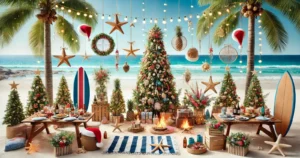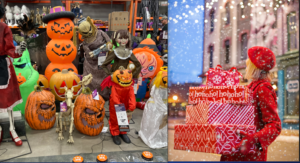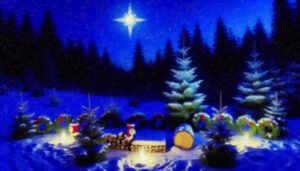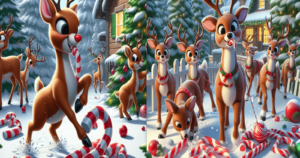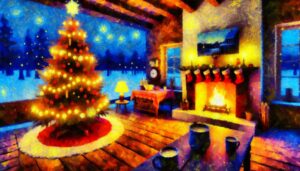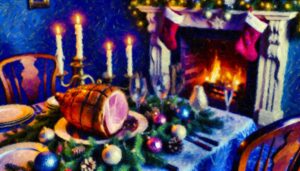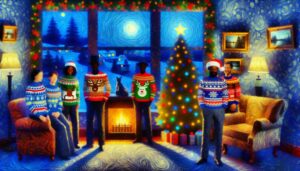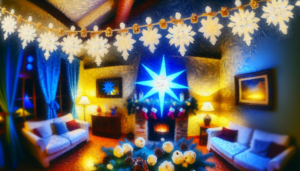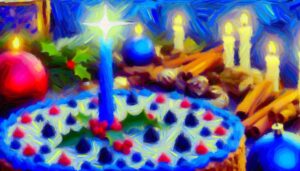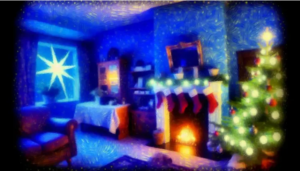Māori culture and traditions are deeply embedded in New Zealand’s identity, and several Māori legends are often shared and celebrated during Christmas time. While Christmas in New Zealand is typically celebrated with general Western customs, Māori culture adds a unique flavor, including the telling of traditional legends that resonate with the spirit of the season. Here are a few famous Māori legends that may be highlighted during Christmas in New Zealand:
1. Māui and the Sun (Māui me te Rā)

Māui, a famous demigod and hero in Māori mythology, is known for many legendary feats, one of which is slowing down the sun. In this story, Māui and his brothers capture the sun, Tama-nui-te-rā, with ropes to slow it down so that the days would be longer. This legend is symbolic of overcoming challenges, an idea that resonates with the themes of perseverance and hope often celebrated during Christmas.
Christmas Connection: The idea of extending daylight ties into the festive nature of the season, where longer days allow for more time with family and community gatherings.
Food as a Celebration of Māui’s Gift
| Food Element | Connection to Māui & the Sun |
|---|---|
| Fresh summer produce | Grown under the long sunlit days Māui created |
| Hāngī | Earth cooking using heat and time – themes from Māui’s control of nature |
| BBQ & outdoor meals | Celebrating sunlight and whānau |
| Seafood (kai moana) | Connection to the sea, nature, and gratitude |
| Pavlova & fruits | Sweet treats that shine under the summer sun |
| Late meals & feasting | Longer days = more time to prepare, eat, and share stories |
2. Tāne Mahuta – The Lord of the Forest
- Summary: Tāne Mahuta is a major figure in Māori mythology, known as the god of forests and birds, and is often referred to as “The Lord of the Forest.” He is one of the many children of Ranginui (Sky Father) and Papatūānuku (Earth Mother).
| Way Tāne Mahuta is Celebrated | Description / Connection |
|---|---|
| Storytelling and Oral Traditions | Māori legends are retold in schools, marae, and homes during holidays, including Christmas. |
| Visits to the Tāne Mahuta Tree | People visit the ancient kauri tree in Waipoua Forest to reflect and honor its sacred status. |
| Cultural Ceremonies and Karakia | Traditional prayers and welcomes are used to show respect for Tāne and the forest. |
| Environmental Activities | Tree planting and conservation efforts celebrate Tāne’s role as guardian of nature. |
| Outdoor Christmas Gatherings | Celebrating in nature during summer reflects the forest’s peaceful spirit, tied to Tāne. |
| Use of Native Trees (e.g., Pōhutukawa) | The red-blooming Pōhutukawa, linked to Māori lore, symbolizes life and is used in Christmas. |
It is a towering kauri tree (Agathis australis) located in the Waipoua Forest of New Zealand’s Northland Region.

He is credited with separating his parents, Ranginui (the Sky Father) and Papatūānuku (the Earth Mother), to bring light into the world. Tāne Mahuta also created the first human, Hineahuone, from the earth.
- Christmas Connection: This legend connects with themes of creation, new beginnings, and the importance of nature, which can be celebrated during Christmas as a time of renewal and appreciation for the natural world.
| Tāne Mahuta (Māori Legend) | Connection to Christmas |
|---|---|
| Guardian of the forest and birds | Many people in New Zealand celebrate Christmas outdoors, in nature or the forest. |
| Separated earth (Papatūānuku) and sky (Ranginui) | Symbolizes new beginnings and light — themes also present during Christmas. |
| Native trees like Pōhutukawa | The Pōhutukawa, known as NZ’s Christmas tree, blooms with red flowers in December. |
| Māori stories passed down through generations | Families share legends like Tāne’s during Christmas, embracing cultural identity. |
| Forest symbolizes peace and reflection | Reflects the quiet, meaningful spirit of Christmas time in New Zealand. |
3.The Legend of the Pōhutukawa Tree – The New Zealand Christmas Tree
- Summary: The Pōhutukawa tree, known as the New Zealand Christmas tree, blooms with bright red flowers in December, making it a natural symbol of Christmas in New Zealand. Māori tradition associates the Pōhutukawa with the legend of a young warrior named Tawhaki, who tried to reach the heavens to seek revenge for his father’s death. Pōhutukawa is also linked to the Māori belief in the cycle of life and death, as it is said to be the resting place of spirits departing for the afterlife.

- Christmas Connection: The Pōhutukawa tree is directly connected to Christmas in New Zealand, symbolizing both the festive season and the cycle of life, reflecting the spiritual side of Christmas.

4. Rona and the Moon (Rona me te Marama)
- Summary: This legend tells the story of Rona, a woman who was taken to the moon after cursing it when she stumbled in the dark. Rona is now believed to live on the moon, and her story is often told to explain the dark shapes seen on the moon’s surface.
The Story:
Rona was a woman who went out one night to fetch water. As she walked through the forest, the moonlight guided her path. But suddenly, a cloud covered the moon, and she stumbled in the dark.
In frustration, Rona cursed the moon for taking away her light.
The moon, offended by her harsh words, reached down from the sky, grabbed Rona, and pulled her up into the heavens—along with her water gourd and the tree she was holding.
From that night on, Rona became part of the moon, and if you look closely, Māori say you can still see her shape on the moon’s surface.
- Christmas Connection: The story of Rona can be seen as a reminder of the power of words and actions, a theme that ties into the goodwill and mindfulness promoted during Christmas.

🌙 Themes and Symbolism:
| Element | Meaning / Symbolism |
|---|---|
| The Moon (Marama) | A powerful celestial being with mana (spiritual power); not to be disrespected. |
| Rona’s Anger | A reminder about the importance of controlling emotions and showing respect. |
| Being Taken to the Moon | A tale of consequence for one’s words — but also eternal connection to nature and sky. |
| Water Gourd & Tree | Represents the everyday tools of life — now immortalized in the moon’s face. |
5. Te Ika-a-Māui – The Fish of Māui
Te Ika-a-Māui means “The Fish of Māui” in te reo Māori, and it’s called that because of a legendary Māori creation story where the North Island of New Zealand is believed to have been fished up from the sea by the demigod Māui.
Here’s why it’s called the fish:
| Aspect | Explanation |
|---|---|
| Māui’s Legendary Act | Māui used a magic hook to pull up a massive fish from the ocean. |
| The “Fish” is the North Island | The fish became what we now know as Te Ika-a-Māui — the North Island. |
| Land Features as Fish Marks | The valleys, mountains, and coastlines represent the cuts and marks made by Māui’s brothers when they tried to divide the fish. |
| Symbolic Naming | Māori tradition uses metaphors; calling the island a fish honors the story. |
- Summary: Māui is credited with fishing up the North Island of New Zealand, Te Ika-a-Māui, using his magical fishhook. This legend explains the formation of the land and is central to the Māori understanding of their place in the world.
🐟 The Story of Te Ika-a-Māui (The Fish of Māui):
Māui was a legendary Polynesian demigod known for his cleverness and magical abilities. One day, he joined his brothers on a fishing trip but hid in the canoe because they didn’t want to bring him.
Once far out at sea, Māui revealed himself and cast a magical fishhook, made from his grandmother’s jawbone, into the ocean while chanting powerful karakia (incantations).
Suddenly, Māui hooked something huge. After a mighty struggle, he pulled up an enormous fish from the depths — Te Ika-a-Māui — which became the North Island of New Zealand.
His brothers, jealous and greedy, began carving up the fish before Māui could properly bless it, which is why the island has so many mountains, valleys, and rugged features today.
🗺️ Symbolism in the Legend:
| Element | Meaning / Symbolism |
|---|---|
| Te Ika-a-Māui (The Fish) | The North Island of New Zealand |
| Māui’s Fishhook | Sacred power, connection to ancestors |
| Carving by Brothers | The natural landscapes and irregular terrain of the island |
| Māui’s Cleverness | Intelligence, bravery, and respect for nature |
🇳🇿 Modern Significance:
- The North Island is still called Te Ika-a-Māui in te reo Māori.
- The South Island is called Te Waka-a-Māui – Māui’s canoe.
- The story is widely taught in schools and is an important part of New Zealand’s cultural identity.
- It features in Māori carvings, artwork, and kapa haka performances.

- Christmas Connection: The story of creation and connection to the land can be celebrated during Christmas as a time of gratitude for the earth and the environment, aligning with the season’s themes of unity and community.
These legends are not directly connected to the Christmas story, but they are part of the rich tapestry of Māori culture that is celebrated alongside Christmas traditions in New Zealand. The fusion of these legends with Christmas customs highlights the unique way New Zealanders celebrate the holiday season.
6. Māui and the Secret of Fire
Māui steals the secret of fire from the goddess Mahuika—a favorite among children for its adventure and magical elements.
The Legend: Māui and the Secret of Fire
Long ago, fire was a closely guarded secret, known only to Mahuika, the goddess of fire. She kept the flames hidden in her fingernails and shared it with humans sparingly.
One day, Māui wanted to understand where fire came from and how it could be controlled. So, he extinguished all the fires in his village and set out to find Mahuika, pretending it was an accident and asking her for more.

Each time, Mahuika pulled a flame from one of her fingernails and gave it to Māui. But Māui kept tricking her by destroying each fire she gave him, asking again and again until she was down to her last fingernail.
Angry at Māui’s deception, Mahuika threw her last flame at him. Māui fled, and the flames scattered, landing in trees and stones.
From then on, humans had to make fire by rubbing wood together or striking rocks — because Mahuika’s fire now lived within those elements.
🔥 Themes and Symbolism
| Element | Symbolism / Meaning |
|---|---|
| Mahuika (Goddess of Fire) | Power, sacred knowledge, and danger of misusing natural forces. |
| Māui’s Trickery | Curiosity and boldness — but also consequences for disrespect. |
| Fire in Fingernails | The fragility and preciousness of fire in early times. |
| Fire in Trees and Stones | Explains the Māori method of creating fire and ties fire to the natural world. |
7. The Journey of Kupe
Kupe was a legendary Polynesian navigator from Hawaiki who is said to have discovered Aotearoa (New Zealand) around 1,000 years ago.
Guided by ocean currents, stars, and birds, he and his crew traveled across the vast Pacific Ocean in a waka (canoe). He is credited with naming many landmarks and setting the foundation for later Māori migration.

Connection to Christmas
Kupe’s story is often told during Christmas gatherings in New Zealand as a way of connecting family to their ancestral roots.
His journey symbolizes discovery, family, and new beginnings—values that align with the Christmas spirit. Schools and communities may include Kupe’s story in holiday plays or cultural events that blend tradition with seasonal celebrations.
list of things and items New Zealanders may share or use to celebrate Kupe’s legacy at Christmas, blending Māori culture with the holiday spirit:
| Item/Thing | Brief Explanation |
|---|---|
| Waka Models or Carvings | Small decorative canoes symbolizing Kupe’s voyage; often used in displays or gifted during Christmas to honor ancestors. |
| Pounamu (Greenstone) Gifts | Traditional Māori gifts representing strength, connection, and heritage, commonly exchanged during Christmas. |
| Koru Decorations | Spiral shapes based on the unfurling fern, representing growth and new life—symbolic during the holiday season. |
| Māori Legend Books | Storybooks about Kupe and other legends are gifted to children during Christmas to pass on cultural knowledge. |
| Poi & Kapa Haka Performances | Cultural performances may be included in Christmas festivals or school shows celebrating legends like Kupe. |
| Kiwi Christmas Cards | Cards may feature Kupe’s journey or waka alongside Santa and summer beach scenes unique to New Zealand. |
| Traditional Songs (Waiata) | Māori waiata are sometimes adapted or included in Christmas carol events, honoring cultural stories like Kupe’s. |
8. The Taniwha
Mythical creatures who live in rivers, lakes, or the sea. Their stories are often shared around Christmas-time camping trips near water.
In Māori mythology, Taniwha are powerful supernatural beings that often take the form of dragons or serpentine sea creatures.
They dwell in deep rivers, lakes, caves, or the ocean and can either protect or harm people, depending on how they are treated.
Some taniwha are guardians (kaitiaki) who watch over tribes, warn of dangers, or protect sacred places. Others are fearsome and dangerous, punishing those who disrespect nature or sacred laws.
The stories of taniwha vary across different iwi (tribes). For example, one tale tells of a taniwha who guarded a lake and only allowed safe passage to those who respected the land and waters.
Another story speaks of a taniwha defeated by a brave ancestor to save the people.

9. Legend of the Seven Stars of Matariki
- While Matariki is mid-winter, the legend is still often told at Christmas as families reflect on ancestors and new beginnings.
Legend of the Seven Stars of Matariki
Matariki is the Māori name for a cluster of stars known internationally as the Pleiades. According to Māori legend, Matariki is a mother (the star Matariki) surrounded by her six daughters: Tupu-ā-nuku, Tupu-ā-rangi, Waipunarangi, Waitī, Waitā, and Ururangi.

The story tells of how the daughters once journeyed across the sky to help their mother bring wellbeing to the Earth.
Each daughter has a special role, tied to the natural world—plants, rain, rivers, sea life, wind, and the sky. Together, they nourish the Earth and support life, guiding the seasonal cycles.

In Māori tradition, the appearance of Matariki in the midwinter sky marks the Māori New Year. It’s a time for remembrance, reflection, honoring ancestors, celebrating nature’s gifts, and sharing food with family and community.
10. The Legend of Hinemoa and Tūtānekai
- A romantic legend of forbidden love and bravery, often told around lakeside gatherings during summer holidays.
Hinemoa was a beautiful and high-born woman from the Te Arawa tribe. She lived on the shores of Lake Rotorua.
Tūtānekai was a brave and noble warrior who lived on Mokoia Island, in the middle of the lake. Although deeply in love, their families did not approve of the match because Tūtānekai was of lower social status.
Each night, Tūtānekai would play his flute across the water, and Hinemoa would listen longingly.
Finally, unable to resist her love any longer, Hinemoa defied her elders. In secret, she tied gourds around herself to help her float and swam across Lake Rotorua to Mokoia Island—guided only by the sound of Tūtānekai’s music.
When she arrived, she hid in a hot spring to warm herself. Eventually, the lovers were reunited, and when the elders saw their devotion, they allowed the couple to be together.

11. The Creation Story – Ranginui and Papatūānuku
The sky father and earth mother were separated by their children to let light into the world—a deeply spiritual tale shared during reflective family times.
In Māori mythology, the creation story begins with Ranginui (the Sky Father) and Papatūānuku (the Earth Mother), who were once tightly bound together in a loving embrace. Their children—powerful gods—were trapped in the darkness between them, longing for space and light.
Among their children were:
- Tāne Mahuta – god of the forest
- Tūmatauenga – god of war and people
- Tangaroa – god of the sea
- Rongo – god of peace and cultivated food
- Haumia-tiketike – god of wild food
- Tāwhirimātea – god of wind and storms
The children decided they must separate their parents to bring light into the world. Each tried and failed—until Tāne Mahuta lay on his back and pushed them apart with his legs. With great effort, he forced Ranginui up into the sky and left Papatūānuku lying beneath him, creating the world of light (Te Ao Mārama).
The separation caused deep sadness. Ranginui wept, and his tears became rain. Papatūānuku groaned, and her sighs became mist. But life flourished between them—forests, oceans, people, and creatures emerged.
However, Tāwhirimātea, angry at the separation, rose in rebellion and scattered violent winds across the land, forever reminding the world of the pain in their parting.
12.Tāwhirimātea and the Winds
- The god of weather battles his brothers after the separation of their parents—an exciting story, especially relevant during stormy summer weather!
Tāwhirimātea is the god of wind and storms in Māori mythology, and one of the many children of Ranginui (Sky Father) and Papatūānuku (Earth Mother). When his siblings decided to separate their parents to bring light into the world, Tāwhirimātea was the only one who opposed this act.
After Tāne Mahuta successfully forced Ranginui and Papatūānuku apart—creating the world of light—Tāwhirimātea was overcome with grief and fury. In his rage, he fled upward to be with his father, Ranginui, and from there, unleashed his wrath upon the Earth.

His revenge:
- He released fierce winds, storms, and lightning, shaking the forests of Tāne Mahuta.
- He sent crashing waves and tempests to battle Tangaroa, god of the sea.
- He stirred chaos in the skies and across the lands, challenging his brothers who had taken part in the separation.
- His rage was especially directed at Tūmatauenga, god of war and mankind, leading to an ongoing struggle between wind and humanity.
Tāwhirimātea’s powerful winds continue to blow today, reminding people of his pain and anger. According to legend, his children are the winds—each one with its own direction, strength, and name. In some traditions, Tāwhirimātea is also said to have torn out his own eyes in sorrow and cast them into the sky—becoming the stars of Matariki.
Resources
https://en.wikipedia.org/wiki/T%C4%81ne_Mahuta

